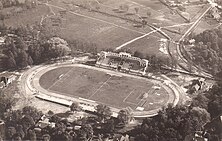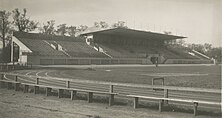 | |
| Former names | Dünamo staadion |
|---|---|
| Location | Tallinn, Estonia |
| Capacity | 5,000 |
| Record attendance | 15,000 (Tallinn vs Riga, 18 August 1942) |
| Field size | 105 m × 66 m (344 ft × 217 ft) |
| Surface | Grass |
| Construction | |
| Broke ground | 1923 |
| Opened | 13 June 1926; 98 years ago (1926-06-13) |
| Renovated | 1936–1938, 1974, 1884–1986, 2000, 2011 |
| Architect | Renner (stadium complex) Karl Burman (1926) Elmar Lohk (1938) |
| Structural engineer | August Komendant (1938) |
| Tenants | |
| Estonia national football team (1926–1940, 1992–2000) FC Flora (1990–2001) FCI Levadia (2000–2018) JK Tallinna Kalev (2020–present) | |
Kadriorg Stadium (Estonian: Kadrioru staadion) is a multi-purpose stadium in Tallinn, Estonia. Opened in 1926, it is one of the oldest stadiums in Estonia. It is currently used mostly for track and field competitions, but also serves as a home ground for JK Tallinna Kalev. The stadium holds 5,000. Grandstand capacity is 3,524 seats and second stand has 1,476 seats. Kadriorg Stadium is located about 2 km east of the city centre in the subdistrict of Kadriorg near Kadriorg Palace. The address of the stadium is Roheline aas 24, 10150 Tallinn.
Kadriorg has been the national athletics stadium of the nation throughout its entire history and was the home ground of the Estonia national football team from its opening in 1926 until the Soviet occupation of Estonia in 1940, and again after the country's re-independence from 1992 until 2000, after which the team moved to A. Le Coq Arena. Throughout its history, Kadriorg Stadium has at some point been the home ground for nearly all of the top-flight football teams of Tallinn, such as FC Flora, Levadia, Kalev, Nõmme Kalju, TJK Legion and TVMK.
Kadriorg Stadium has hosted the European Athletics U23 Championships in 2015 and 2021, as well as the European Athletics U20 Championships in 2011 and 2021. It was also one of the venues for the 2012 UEFA European U19 Championship.
History

Kadriorg Stadium was opened on 13 June 1926, eight years after Estonia had become independent. The stadium's opening event was attended by 15,000 people and saw Estonia beat Lithuania 3–1 in football. The stadium complex was designed by German architect Renner and the first wooden grandstand by Estonian architect Karl Burman. Upon completion, the stadium was inaugurated as the country's national stadium and was considered to be the finest of the Baltic states.
Despite its grand look, the 2,500-capacity grandstand quickly proved to be too small to facilitate the growing number of spectators and underwent an expansion in 1934, before an inspection in 1935 found the wooden structure to be in need of immediate repairs as it was in danger of collapsing.
A design competition for a new grandstand was held in the spring of 1936 and the project of Estonian architect Elmar Lohk was chosen, mainly due to his innovative solution to lead the spectators to their seats through passages from the back of the grandstand, unlike the then commonly used approach in Europe that often saw spectators enter the stand from the front. The construction began in late 1936 and was finished in a year, by late 1937.

With its freestanding concrete roof, the new grandstand was believed to be one of the most modern in Europe at the time and was seen as an outstanding achievement in the field of reinforced concrete structures. The stadium was officially re-opened on 15 May 1938 with great celebration by the first president of Estonia Konstantin Päts. The opening event saw Estonia draw 1–1 with RC Strasbourg in front of 8,000 people. A year later, World War II had reached Estonia and the country was occupied by the Soviet Union, after which Kadriorg Stadium was renamed as Dünamo staadion.

During the Soviet occupation, the stadium continued to be one of the primary sports venues of the region and hosted a number of international and Soviet wide athletics competitions, most notably the Soviet Union – USA – West Germany decathlon event in 1974 and the Soviet Union – East Germany athletics competition in 1986. The 1986 event also saw two athletics world records set in Kadriorg, when Yuriy Sedykh set a world record of 86.66 m in hammer throw and Heike Drechsler a world record of 7.45 m in women's long jump.
In 1992, the stadium hosted the first match of the Estonia national football team after the country's re-independence, when Estonia drew 1–1 with Slovenia. It was also the location of the infamous "One team in Tallinn" fixture between Estonia and Scotland, which was abandoned after three seconds when the home team refused to turn up, in protest at the game's kick-off time being brought forward several hours. The national team's last match in Kadriorg took place on 3 September 2000 against Portugal, after which the team moved to A. Le Coq Arena.
In 2011, Kadriorg Stadium hosted the 21st European Athletics Junior Championships. The stadium was one of the venues for the 2012 UEFA European U19 Championship and hosted three group stage matches. In 2015, the stadium hosted the U23 European Athletics Championships. In 2021, Kadriorg hosted both U20 and U23 European Athletics Championships.
Future
For Kadriorg Stadium's 100th birthday in 2026, the City of Tallinn will renovate the complex for €20 million. The renovation will see the complete refurbishment of the sports field and the historic grandstand, as well as the construction of a new 1,600-seat stand on the opposite side of the field. Additionally, a new 1,000-seat football ground will be built behind the main stadium, next to the current athletics training field. The new football ground will also have its own administrative building that would be connected with the grandstand by a planned tunnel. The first works began in 2023, when floodlights were installed for the main stadium and its both training fields.
Grandstand

Kadriorg Stadium's current grandstand was opened in 1938 and is an official cultural heritage monument. Designed by architect Elmar Lohk and famous engineer August Komendant, it was seen during its time as an outstanding achievement in the field of reinforced concrete structures and was mostly noted for its 12.8 m long and 51 m wide cantilever concrete roof, the largest in the world at the time. The grandstand has also been brought out by world-famous architectural critic Kenneth Frampton as one of the most outstanding and historic concrete structures in Estonia.
Athletics records
World records
Kadriorg Stadium has seen three world records in athletics. The first two were set during the 1986 Soviet Union – East Germany athletics competition, where Yuriy Sedykh set a world record of 86.66 m in the hammer throw and Heike Drechsler a world record of 7.45 m in women's long jump. The stadium saw its third world record in 2006, when Tatyana Lysenko threw 77.80 m in women's hammer throw.
Stadium records
Updated on 1 January 2024.
Men
Women
See also
References
- Kadrioru staadion – Ajalugu
- Schwede, Indrek (2021). "Jalgpalli positsioonist Eestis ja selle marginaliseerumise põhjustest Nõukogude anneksiooni perioodil". Tartu Ülikooli Kirjastus: 69.
- EOK – Spordirajatised — KADRIORU STAADION
- Info on homepage
- "Staadion!". Eesti Spordileht. 11 June 1926.
- ^ "Kadrioru staadion - Ajalugu - Ülevaade staadioni ehitusest". www.kadriorustaadion.ee.
- "Katusega tribüün Kadrioru staadionile". Päewaleht. 5 April 1936.
- "Kadrioru staadion – moodsamaid Euroopas". Postimees. 9 January 1938.
- Retro: Kadrioru staadioni tribüüni avamine, Youtube, retrieved 2023-01-13
- Shaw, Phil (10 October 1996). "Scotland await verdict after Estonian farce". The Independent. Retrieved 6 February 2023.
- "Kadriorg Stadium to get second full-size football pitch after renovations". ERR. 17 October 2023.
- ^ Schwede, Indrek (October 2023). "Kadrioru staadion sajanda juubeli eel: harjutusväljakust saab võistluspaik". Jalka.
- "Kadrioru staadionihoonet peetakse oluliseks arhitektuurimälestiseks". ERR (in Estonian). 23 October 2015.
- "Athletics records". kadriorustaadion.ee.
External links
- Official website
- History of Kadriorg Stadium (in Estonian)
- (Video) Opening of the stadium's new grandstand in 1938
59°26′4.10″N 24°47′0.40″E / 59.4344722°N 24.7834444°E / 59.4344722; 24.7834444
Categories: